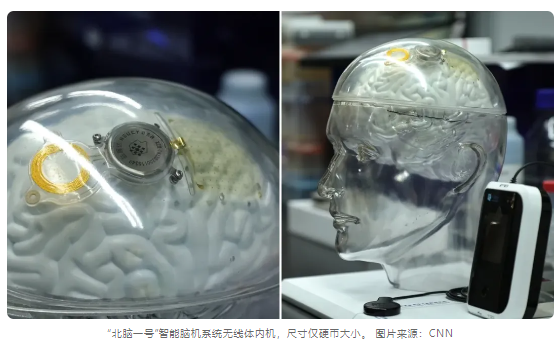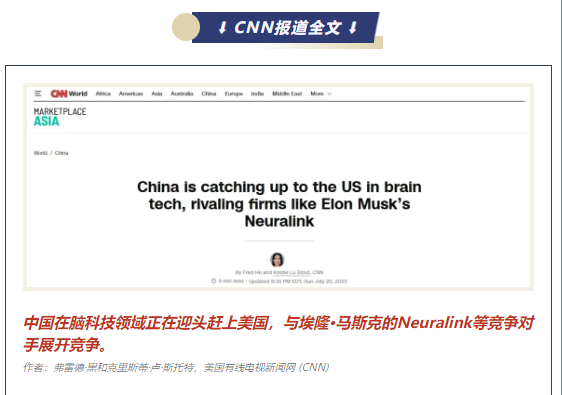“我想吃飯”——看似簡單的四個字��,卻是從一位因漸凍癥(ALS)導(dǎo)致言語障礙的67歲患者腦中“躍”上屏幕的�! 這并非電影場景�����,而是國產(chǎn)“北腦一號”智能腦機系統(tǒng)帶來的真實突破:硬幣大小的無線設(shè)備植入患者大腦����,成功解碼其腦電信號并轉(zhuǎn)化為中文文字,并展現(xiàn)出令人振奮的高精準度——出院前62詞解碼準確度可達63%��,能解碼輸出近百個常用語句��。

腦機接口技術(shù)最早于20世紀70年代出現(xiàn)在美國���。相比之下�,中國在該領(lǐng)域的研究起步稍晚,但攻堅步伐正快速逼近國際先進水平�����。在北京腦科學(xué)與類腦研究所����、北京芯智達神經(jīng)技術(shù)有限公司的聯(lián)合攻關(guān)下���,在柔性電極、解碼算法���、設(shè)備集成等方面展現(xiàn)出強勁的技術(shù)追趕與創(chuàng)新能力。截至目前����,“北腦一號”智能腦機系統(tǒng)已實現(xiàn)5例人體植入,成功幫助言語��、運動障礙患者“用想象說話”�、“用意念行走”。
例如�����,團隊于今年5月份為一名胸腰椎段脊髓損傷導(dǎo)致下肢癱瘓已有五年的患者進行了腦機設(shè)備植入��,術(shù)后患者可通過“北腦一號”�����,腦控脊髓電刺激裝置和下肢康復(fù)外骨骼��,實現(xiàn)運動意圖解碼控制脊髓電刺激激活和外骨骼輔助運動�。經(jīng)過四周左右的腦控康復(fù)訓(xùn)練,患者二便功能已得到改善�,雙下肢肌力均得到提升,開始能夠控制腿部運動��,例如移動大腿�����、輕微踢小腿���。
“北腦一號”臨床進度已與馬斯克Neuralink公司持平。盡管兩者在植入方式����、信號精度及適用場景上路徑不同,但“北腦一號”正逐步在安全性與實用性之間找到獨特平衡��,成為國內(nèi)自主腦機技術(shù)崛起的重要標志�����。下一步���,團隊計劃在未來一年為50至100名新增患者進行植入��。
北京時間7月21日上午,美國有線電視新聞網(wǎng)(CNN)就“北腦一號”智能腦機系統(tǒng)最新進展進行深度報道����。在這場面向未來的科技競賽中,中國方案正快速走上國際舞臺��。

“我想吃”以漢字的形式出現(xiàn)在位于北京中部的一家公立醫(yī)院的電腦上����。這些字是由一位67歲的女性的思緒所形成的,這位女性患有肌萎縮側(cè)索硬化癥(ALS)��,也被稱為露西爾·格雷格?��。裏o法說話����。
北京廣播電視臺在3月拍攝的演示是涉及五名植入名為“北腦1”的硬幣大小芯片的臨床試驗的一部分����,該芯片是一種無線的所謂腦機接口(BCI)——這一技術(shù)由美國科學(xué)家引領(lǐng)�����,但專家表示中國正在迅速迎頭趕上�。
羅敏敏,北京腦科學(xué)與類腦研究中心(CIBR)主任�、該試驗的首席科學(xué)家表示��,腦機接口(BCI)技術(shù)有著“非常強烈的需求”�����,他說���,這些技術(shù)已經(jīng)“淹沒”了潛在患者的要求�����。
“患者們表示��,這感覺非常好�����,就像他們可以重新獲得或恢復(fù)對肌肉的控制���,”他在今年五月接受CNN采訪時說,這次采訪是在他位于北京宣武醫(yī)院一小時車程外的實驗室里進行的����,試驗就在這里進行���。
羅說�,該技術(shù)在解碼患者的大腦信號并將其轉(zhuǎn)化為文本語音或機器動作方面表現(xiàn)出“高精度”�。他的團隊計劃在接下來的一年中,通過向50到100名更多的患者植入芯片來加快人體試驗�。
“我們希望這個過程能夠加快?���!彼f�?��!叭绻蛔C明是安全且有效的……它可以在全球臨床中使用?�!?/p>
截至五月�,Beinao-1表示,共有五名患者植入了其設(shè)備��,與埃隆·馬斯克的Neuralink相同�。另一家美國公司Synchron的投資者包括杰夫·貝佐斯和比爾·蓋茨,該公司已在10名患者身上進行了試驗����,其中在美國的有六人��,在澳大利亞的有四人���。
喬治城大學(xué)神經(jīng)科學(xué)教授Maximilian Riesenhuber(未參與北農(nóng)試驗)告訴CNN�,盡管中國開始得比美國晚�����,但中國正在取得進展�����。
“中國無疑已經(jīng)展示了不僅能夠迎頭趕上,而且還能具有競爭力���,并且現(xiàn)在實際上已經(jīng)開始在某些領(lǐng)域引領(lǐng)發(fā)展��,”他說����。“令人興奮的是����,兩國都有很多研究活動,因為他們已經(jīng)意識到了腦機接口的潛力�。”
根據(jù)市場調(diào)研公司Precedence Research的報告��,去年大腦技術(shù)市場價值約為26億美元�����,并預(yù)計到2034年將增長到124億美元�����。但是對中國和美國來說���,這項技術(shù)的意義遠不止于此���。
不同的方法
CIBR 由北京市政府和幾所本地大學(xué)于2018年共同創(chuàng)立,大約在埃隆·馬斯克在舊金山附近創(chuàng)立Neuralink兩年后�����。
2023年��,CIBR孵化了一家名為NeuCyber NeuroTech的私營公司�,專注于腦科技產(chǎn)品的開發(fā),如Beinao-1����。羅也是這家初創(chuàng)公司的首席科學(xué)家���,他于5月罕見地向CNN展示了該研究所��。
他說�����,這位60多歲的肌萎縮側(cè)索硬化癥患者多年來無法表達自己��。
“她已經(jīng)蘇醒����,她知道自己想要什么,但她無法表達出來��,”這位科學(xué)家說。他在賓夕法尼亞大學(xué)獲得神經(jīng)科學(xué)博士學(xué)位����,并在美國度過了近十年的時間?�!霸谥踩牒?���,她現(xiàn)在可以通過該系統(tǒng)非常準確地說一些簡單的句子?!?/p>
所有BCI研究人員都必須解決風(fēng)險與效果之間的平衡問題。
Riensenhuber 表示����,大多數(shù)美國公司使用更侵入性的方法將芯片放置在硬腦膜內(nèi),硬腦膜是覆蓋和保護大腦和脊髓的外層組織���,以獲得更好的信號���。但是這些方法需要更危險的手術(shù)。
“有趣的是�,NeuCyber 顯然能夠通過大腦皮層表面獲取足夠的信息來解碼特定的單詞,”他說��。
對ALS患者的測試于三月開始��,標志著Beinao-1芯片在人體上的第三次試驗���。這些試驗構(gòu)成了開發(fā)者在新聞稿中所描述的“世界上第一批半侵入式無線BCI植入人體大腦”的內(nèi)容。截至五月�����,又進行了兩次試驗�����,總共進行了五次。
腦機接口技術(shù)最早于20世紀70年代在美國開始��。
Decades later, the Obama Administration launched its “Brain Initiative”?in 2013, investing more than $3 billion to fund over a thousand neuroscience technology projects since, according to the National Institute of Health.
Synchron, based in New York, was the first firm to start human trials in July 2021. Three years later, a new BCI system developed at UC Davis Health translated the brain signals of an ALS patient into speech, achieving an accuracy of 97% – the most accurate system of its kind, the university said in a statement. The same year, Musk’s company completed its first human trial, enabling the participant to control a computer mouse with a brain implant.
China got its start in brain tech only in the 1990s, but it’s advancing fast. In 2014, Chinese scientists introduced the idea of a national project on brain tech to match similar efforts in the US and Europe, according to the Ministry of Science and Technology. Two years later, brain tech was mentioned in the country’s five-year plan, which outlines China’s national priorities and goals.
“Brain science is new in China,” said Lily Lin, a former research assistant at one of China’s top neuroscience research units from 2021 to 2023. “So, it started a bit late, but its speed of development has been faster than other countries. And the country has given a lot of funding to many scientific research units, and this funding is increasing every year.”
Last year, the government issued its first ethical guidelines for research in this area. At the local level, municipal governments in Beijing, Shanghai and other major cities have also offered support for brain technology companies from research and clinical trials to commercialization.
Riesenhuber and other researchers from Georgetown University published research on China’s BCI development in 2024, stating that efforts from Chinese researchers were “comparable in sophistication” to those in the US and the United Kingdom.
“We found China’s non-invasive BCI research to be comparable with that of other scientifically advanced nations and to be working to overcome obstacles to greater fidelity, throughput, and wider use,” according to the issue brief. “China’s invasive BCI research, while historically behind its non-invasive efforts, has picked up the pace and is approaching global standards of sophistication.”
Luo, who has worked in both countries, says the US is the “front-runner” in both invasive and non-invasive brain tech. But, comparing Beinao-1 and Neuralink is like looking at “apples and oranges,” he added.
The two systems differ not only in implant location but also in the type of brain signals recorded, as well as the method of data transmission. The Chinese chip records a wider range of brain areas, with lower precision for each neuron.
“總的來說�,我認為這兩款產(chǎn)品之間沒有競爭或排他關(guān)系���,”羅補充道�����?��!澳壳斑€無法定論�,我們還不知道哪條路最終會更好地造福患者���?���!?/p>
美鳳力借多年的大動物經(jīng)驗����,堅持以“務(wù)實求真”為宗旨,累計為4000多家客戶提供品質(zhì)大動物臨床前服務(wù)��,得到了客戶的一致好評�����。如果您有動物試驗�����、臨床培訓(xùn)���、組織病理���、大動物試驗、臨床試驗�����、產(chǎn)品注冊科研課題等...
請立即點擊咨詢我們或撥打咨詢熱線: 17312606166 ���,我們會詳細為你一一解答你心中的疑難���。 添加好友





 17312606166
17312606166